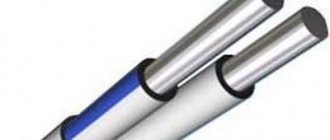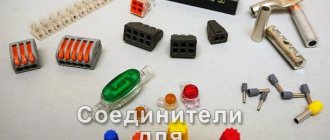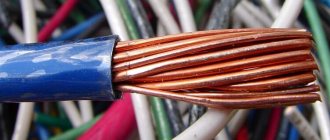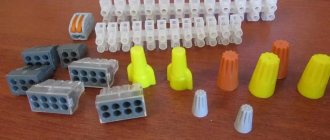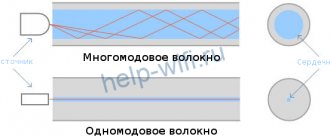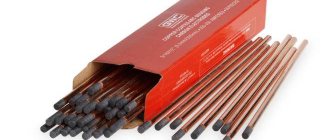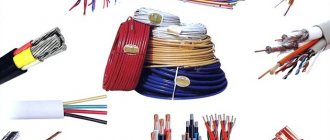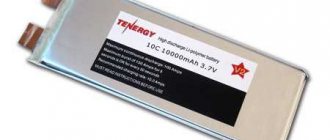The use of aluminum wires for electrical wiring is prohibited by the Electrical Installation Rules. However, these conductors are used to connect electrical installations with a cross-section of more than sixteen square millimeters.
Typically, such equipment is specialized devices such as pumps, climate control units and other powerful installations.
Even taking into account the narrow specialization, conductors of this type are still in great demand. This is influenced by several key factors:
- Cost-effectiveness of materials. Aluminum materials are cheaper than copper conductors.
- When you need to replace part of the wiring, but there is no money for an expensive copper conductor.
Today we will talk about the advantages and disadvantages of aluminum wires and cables.
Official bans
The “dislike” went so far that aluminum was officially restricted in its rights. Let's see what the official documents say about the use of aluminum, which should guide designers and electricians if they have an idea to use aluminum in their activities.
The first thing to note is PUE-7, clause 7.1.34 , which clearly states: “Cables and wires with copper conductors should be used in buildings (...).” We are talking about all buildings, except for industrial buildings - residential, public, administrative and domestic. In the same paragraph there is a footnote that states that aluminum was allowed to be used in buildings built before 2001. The ban on aluminum wiring was finalized by order of the Russian Ministry of Energy dated June 20, 2003.
Also, the PUE (Table 7.1.1) talks about the minimum cross-section of wires in the lines of group networks (inside our homes). Only copper wire with a cross-section of at least 1.5 mm² is allowed.
Another popular document is the Code of Practice SP 256.1325800.2016 “Electrical installations of residential and public buildings. Rules for design and installation” ( clause 15.3 ) – echoes almost word for word: “Internal electrical networks must be flame retardant and carried out with cables and wires with copper conductors, busbars with copper busbars (...).”
It’s worth making a reservation and jumping ahead a little: here I’m talking about the first version of these documents. I will write about the changes further in the text.
At the same time, both documents state in the same paragraphs that aluminum still has the right to life. PUE, (clause 7.1.34): “Supply and distribution networks, as a rule, must be made of cables and wires with aluminum conductors, if their design cross-section is 16 mm2 or more.” In the SP (clause 15.3) the wording is more streamlined - “use is allowed.” In any case, such a section in an apartment can only be used as an input, and it will not be possible to connect an outlet.
But why is aluminum allowed to be used if it is so problematic?
Results and recommendations
Just a visual count of the number of advantages and disadvantages of aluminum conductors, as well as a quick assessment of the volume of text in each of the thematic sections, allows us to unequivocally state that copper wires have much more acceptable technical characteristics, they are more compact, more reliable, more durable, easier to install, and much less common. cause accidents. Perhaps their only serious disadvantage is their rather high cost. However, a good owner, customer or designer will most likely prefer to “pay and forget” than to spend time and significant funds on constant monitoring, maintenance and repair of aluminum wire lines.
To be fair, let us clarify that the above is quite true for cable products of small cross-sections. But if the diameter of the wires is more than 16 mm2, and its footage is measured in kilometers, as when installing an overhead line, then the “cost of the issue” will be decisive. At the moment, the PUE also adheres to this opinion, and therefore does not prohibit the use of aluminum for large cross-section electrical cables.
If you plan to completely replace apartment wires, then it should be done only with copper and aluminum should be removed right up to the shield, because these metals are not very “friendly” and will not allow the electrical network to work at full capacity.
Thoughtful reading of this article, the ability to reason and think logically, will allow everyone to independently draw conclusions about which wire is better, copper or aluminum
, and why the latter is not advisable to use, especially for the installation of small household electrical networks.
Pros of aluminum
With the same cross-section of wires made of copper and aluminum, the disadvantages of aluminum outweigh its main advantage - the price.
But it’s not for nothing that the documents indicate a certain limit - 16 mm². After this, the price of the cable becomes a decisive factor, and copper fades into the background. But the price is not only the cost of electrical wiring. There is another important circumstance due to mentality. Large squares are usually (or rather always) located outside residential premises. This means that such a cable, if it is copper, can “lie poorly” and can be “damaged.” With aluminum this risk is less.
It is necessary to compare copper and aluminum at the same maximum permissible current that the compared specimens can withstand.
I was not too lazy, went to the site (too famous to name) and compared prices for copper and aluminum cables, identical in terms of permissible continuous current.
Comparison of the price of copper and aluminum cables, identical in terms of permissible continuous current
As can be seen from the table, the difference is significant. Moreover, with 16 mm² aluminum becomes full-fledged and legitimate according to all laws. Starting with a section of 10/16 (copper/aluminum) with a difference in price of 3 or more times, the savings are huge.
What about smaller sections? There, after all, the savings are even greater - 5 times or more! I would like to save money, but I can’t - as I said above, it is prohibited to use aluminum cross-sections less than 16 mm².
However, in the same paragraphs (PUE 7.1.34, SP 15.3) there is a “loophole” - the engineering equipment of buildings (pumps, fans, heaters, etc.) can be carried out with wires and cables with a core cross-section of 2.5 mm or more. For example, if fire pumps and smoke removal pumps in a multi-story building are connected with aluminum cable, you can save tens of thousands of rubles!
Cables ABBГ, ABBGE
Cables of the AVVG, AVVGE brands are intended for laying cable lines in cable structures and premises.
Cables of the AVVGE brand, in the design of which an electrically conductive screen made of wires or tapes is placed under the sheath, are recommended for installation in rooms with a high required level of electrical protection, incl. for use in hazardous areas.
The operating temperature of the cable should be no more than 70 degrees Celsius. The power cable can be heated up to +160 degrees if it is protected with polyvinyl chloride insulation, and up to +130 degrees if the cable is protected with polyethylene insulation.
How to turn a minus of aluminum into a plus?
With new technologies, a lot has changed in recent years.
Technologies for the production of aluminum alloys also do not stand still. Several years ago, Russia mastered the production of aluminum alloys of grades 8176 and 8030 (common name - 8000 or 8xxx), which include copper, iron and other additives. Technical conditions for these alloys are given in GOST R 58019-2017.
Production has been mastered, but its use is prohibited, what to do? Changes were made to PUE 7.1.34, which I wrote about above. For this purpose, a multi-pass procedure was carried out. Watch your hands.
On October 16, 2017, the Ministry of Energy of Russia issued Order No. 968 “Safety Rules for Power Receiving Installations. Features of electrical wiring in buildings with conductive copper conductors or conductors made of aluminum alloys.” As I briefly understood the essence of this Order, aluminum wiring with a cross-section of less than 16 mm² is approved for use in residential buildings if it meets certain requirements - in particular, the resistance and chemical composition of the conductor . The minimum permissible cross-sections for different types of supply lines are also indicated.
It turned out to be an incident (of which, however, there are a lot in the regulatory framework) - both the ban was in force (PUE, clause 1.7.34) and the permit for aluminum wiring (order No. 968).
To overcome this contradiction, on December 20, 2017, the same Ministry of Energy issued another order - No. 1196 , which states in plain text that the 1st and 6th paragraphs of clause 7.1.34 of the PUE are invalid. That is, the requirement “Cables and wires with copper conductors should be used in buildings” and Table 7.1.1 have been canceled.
And here it turns out that, in particular, cables of the type AsVVG (for fixed wiring, with flexibility class 1) and AsKG (analogue of copper flexible cables, with flexibility class 5), the conductors of which are made of aluminum alloys 8xxx, are ideally suited to the actions of Order No. 968 . And only them. Although this is not stated explicitly.
Cable AsVVG – 4 cores
It seems that the secret information from my good friend Public Health has been confirmed - changes in legislation occurred at the instigation of the RusAl company and cable manufacturers that are part of the Aluminum Association.
What about the set of rules SP 256.1325800.2016? Regarding aluminum, changes No. 2 and No. 3 , approved and put into effect in 2022 by orders of the Ministry of Construction No. 588/pr and No. 288/pr. They are much more specific.
These changes, first of all, change clause 15.3, which I mentioned above: “Internal electrical networks must be flame retardant and made with cables and wires with conductors made of copper or aluminum alloys of grades 8030 and 8176 (...).” Table 15.3 and some other paragraphs have also been added, which include conductive cores made of new alloys. Table 15.3, which lists copper and new aluminum alloys, talks about minimum cross-sections. The minimum cross-section for socket groups is 2.5 mm2. This is a more strict rule than in the PUE (Table 7.1.1). Plus, it's newer. Therefore, we always set 2.5 mm2 on sockets, regardless of the machine.
In addition to the PUE and SP, changes have been made to GOST 31996-2012 “Power cables with plastic insulation for a rated voltage of 0.66; 1 and 3 kV”, which now produces not only cables with a copper core, but also cables with a core made of new alloys.
What is the asking price?
I wonder how the price of “new” aluminum will change compared to old? I made this comparison table:
Comparison of prices of “old” aluminum cables and new ones, with an 8xxx aluminum core
It can be seen that the price of cables that entered the legal field a couple of years ago differs by 2.5-3 times from cables with “old” aluminum. Competitive advantage! However, their price is significantly lower than copper ones with a similar permissible continuous current.
Further, the prices are almost the same, since cross-sections of 6 and 10 mm² are practically not used in residential wiring, and if a larger cross-section is required, even older brands of cables can cope quite successfully and legally.
Power cables with aluminum core: design
The power cable with aluminum core has a standard design for cable products. Single-wire or multi-wire aluminum conductors (not pure aluminum, but an alloy) are surrounded by PVC insulation. All cable cores are twisted into a bundle and surrounded by a common PVC sheath. Depending on the modification, the cable may additionally be protected with armored tape and/or have additional paper insulation. Cables with this design are called power cables with an aluminum core in PVC insulation and they are the most widespread.
The following popular brands of aluminum power cables can be distinguished:
Similar
Important clarification for aluminum opponents
It is clear that professional electricians, who every day see burnt strands of copper and aluminum and melted terminals with aluminum wires, are categorically against the innovation. Therefore, it is important to clarify:
- aluminum will only be used in new buildings (apartments, houses), where ALL wiring will be aluminum, connections and transitions to copper will be made by professionals, and the quality of work will be confirmed by examination. At least that's how it should be;
- It is allowed to use only 8xxx aluminum alloys, from which the current-carrying core of the AsVVG and AsKG cables is made. Cables based on “old aluminum” are not subject to the new changes and are still “outside the law”;
- no one prohibits the use of copper wires - if the client is willing to pay for copper, as before, please! Something tells me that now the price of copper cables may decrease slightly due to competition with new aluminum.
The main thing is that developers will have a completely legal way to make the price of electrical wiring in “construction option” apartments 10-15% lower than before. In secret from the same open secret, the majority of large developers (for example, Glavstroy, PIK) recently made a final decision - to use aluminum cable instead of copper at all newly built facilities.
A little historical background
Under the USSR, they didn’t ask which wire was better, copper or aluminum
, simply because copper was almost never used for electrical wiring. Many of us know from personal experience that in any house that is more than 15-20 years old, the main task of powering apartments is still performed by aluminum wires. By the way, the internal wiring is made of the same material, and this sometimes becomes a huge problem, but more on that below.
Under the Union, they did not always care about the quality of life of their citizens, so they could make products from cheaper ingredients, because the scale of savings within the vast country was impressive. To be objective, it should be said that few people planned to operate residential buildings not for 15-20 years, but for 30-40-50, and many of them will last a couple more decades. And replacing the collapsing wiring would be a simple matter - new, perhaps more comfortable buildings would still be built, and the power lines would not turn into an unpleasant and extremely dangerous “something.” In addition, at that time there were no such loads on power lines, which means there was no reason to put excess power into cables.
What about the sockets?
The cable is not used on its own. As a rule, in apartments it starts from the terminals of circuit breakers and zero buses, and ends at electrical installation products (EUI).
Most manufacturers of model equipment, even before the changes were released, indicated the possibility of connecting both copper and aluminum conductors to the contact terminals. But there was also a small clarification: once every 6 months you need to extend contacts.
After the changes were released, EUI manufacturers quickly came to their senses and began producing sockets and switches with special terminals. It is also important that these terminals accept a conductor with a cross-section of 4 mm² without any problems.
Quart sockets for copper and aluminum up to 4 mm2
To make everything official, changes were made to GOST IEC 60884 for household sockets and GOST IEC 61545 for contact connections (2022 versions). For those who like to dig deep, I recommend checking it out.
Brands of aluminum wires
SIP is a self-supporting insulated wire. Used in overhead power lines with voltages up to 35 kV. The number of cores is from 1 to 4. The marking looks like this: “SIP 1, SIP 2” and so on. If there is a letter “A” after the number, then the zero core is insulated; if not, then the zero is without insulation. The cores are covered with UV-resistant polyethylene. The number of cores and their design may vary depending on the marking. A distinctive feature of the SIP 3 brand is that it is a single-core steel-aluminum wire.
APV - aluminum wire with a monolithic insulated core, produced in the cross-section range from 2.5 to 16 sq. mm. Used for assembling electrical circuits, panels and cabinets, and can be used for assembling lighting fittings. Products of this brand are installed in walls, pipes, and trays. Designed for voltages up to 1000 V 50 Hz. Insulation material – PVC plastic.
A – bare wire, used on overhead power lines. Wires consist of thin wires twisted into what is called a twist. Section range 16-750 sq. mm.
AC is a non-insulated wire, differs from the previous one only in the presence of a steel core, which makes it more rigid and resistant to mechanical stress.
Conclusions – cautious
It is not entirely clear to me how the reliability and safety of electrical wiring increases, as stated in the orders. It is unlikely that new alloys surpass the classic “GOST” copper in their parameters. It is not clear how reliability will increase.
Since, with all identical parameters, the cross-section of the core and the diameter of the cable will be increased, this will complicate the life of the electrician - after all, connecting and laying cables will be difficult. There is no doubt that ordinary hard workers who will need to master new technologies will spit at first.
Personally, I am not against business and technology development. The main thing is that the use of 8xxx aluminum alloys really gives the advantages that are stated - low price, safety and reliability.
Wait and see!
Addition
The topic is well covered here – https://aluminium-guide.com/novaya-alyuminievaya-provodka/
and in my group VK SamElectric.ru.
The article was originally published on the Elec.ru portal here: Old New Aluminum, as well as in the Electrotechnical Market magazine.
The magazine article can be downloaded and read here: • Old new aluminum / Article in the journal Electrical Engineering Market, pdf, 2.5 MB, downloaded: 115 times. /
That’s all, I’m waiting for interesting comments!
